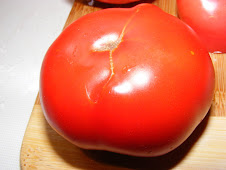Black Pear is looking fantastic. She's even got little flower buds on her. I received this plant from a fellow gardener, who obviously has an incredibly green thumb! You can read more about her garden and green thumb here. It wasn't on my list of tomatoes this year, but how can you say no to a nice healthy plant?
 My drip water set up. I saved a bunch of these 2 liter milk jugs all winter to use in the garden this summer. During the colder weeks of April and May, they were filled with hot water to regulate the temperatures in my row tunnels at night. They did the trick, and now they are pulling another shift as watering bottles. I poked two holes in the bottom, with a screw, and planted them between the tomatoes, not quite half way. When I want to fertilize or water, I just fill them up, and the water trickles out the holes. Caps are on to keep bugs and dirt out while they're not in use. I timed it, and it takes about 5 minutes for the bottles to empty out. It doesn't look the prettiest, but it should do the job.
My drip water set up. I saved a bunch of these 2 liter milk jugs all winter to use in the garden this summer. During the colder weeks of April and May, they were filled with hot water to regulate the temperatures in my row tunnels at night. They did the trick, and now they are pulling another shift as watering bottles. I poked two holes in the bottom, with a screw, and planted them between the tomatoes, not quite half way. When I want to fertilize or water, I just fill them up, and the water trickles out the holes. Caps are on to keep bugs and dirt out while they're not in use. I timed it, and it takes about 5 minutes for the bottles to empty out. It doesn't look the prettiest, but it should do the job.
Silvery Fir Tree was also a last minute addition this year. I wanted to grow it, did some research and decided against it (finicky, not a great producer, just plain old a real pain in the ass kinda tomato - not what I want), and then I was sent some seeds! Go figure.
Out of twenty or so seeds, two germinated. It was already living up to its reputation! This one is looking pretty good though, so I'll see what happens with it. It has very distinct, lacy foliage, hence the name and the reason I wanted to try it in the first place. My little garden helper also does double duty as the official tomato taste tester, and she can't wait!
 We've had a few off of the 'Galina's Yellow' that I have been growing since Christmas, but the plant is definitely not GY. The tomatoes are small, orange tasty little things, and the foliage is not potato leafed, as is GY. The seeds must have gotten crossed, who knows with what, but we like the result! My plants are open-pollinated, so if I do save seeds to trade, to sell plants or to preserve that particular variety, I will bag the blossoms. If it's just for me and my future growing, it's no biggie to have crossed seeds. Whatever it produces will be eaten!
We've had a few off of the 'Galina's Yellow' that I have been growing since Christmas, but the plant is definitely not GY. The tomatoes are small, orange tasty little things, and the foliage is not potato leafed, as is GY. The seeds must have gotten crossed, who knows with what, but we like the result! My plants are open-pollinated, so if I do save seeds to trade, to sell plants or to preserve that particular variety, I will bag the blossoms. If it's just for me and my future growing, it's no biggie to have crossed seeds. Whatever it produces will be eaten!Pictured here are the Santalina's I've mentioned before. The first three are the ones planted with the compost and epsom salts. The last three don't seem to be very happy. I think I'll pull them to make room for something else. You can also see a patch of Swiss Chard in there. No neat, organized rows here!

And finally, my grid garden, which used to be the sandbox, aka the neighborhood cat litter box. We dug out most of the sand, and emptied one of the small square raised beds into it. It now contains three squares of carrots, three squares of lettuce, green onions, bok choy, spinach, snow peas, snap peas, basil, parsley and a bunch of strawberry plants. It is surrounded by delicious red raspberry plants that wandered over from my neighbors and I welcomed happily into my yard. He has since dug all his up, and seeded his yard with grass.
In the front bed, my baby Brugs, grown from seed, now two and half years old. They should flower this year. V.Peach X Frosty Pink, so there might be something there, or they could be all white. I'm going to plant some other annuals in there to keep them company. Maybe just throw in some marigold and cosmos seeds. And I need to get some more mulch.
















